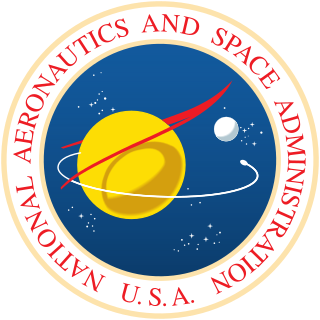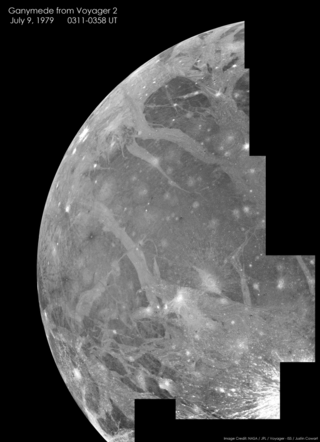
Space exploration is the use of astronomy and space technology to explore outer space. While the exploration of space is currently carried out mainly by astronomers with telescopes, its physical exploration is conducted both by uncrewed robotic space probes and human spaceflight. Space exploration, like its classical form astronomy, is one of the main sources for space science.

Phobos is the innermost and larger of the two natural satellites of Mars, the other being Deimos. The two moons were discovered in 1877 by American astronomer Asaph Hall. Phobos is named after the Greek god of fear and panic, who is the son of Ares (Mars) and twin brother of Deimos.

The Discovery Program is a series of Solar System exploration missions funded by the U.S. National Aeronautics and Space Administration (NASA) through its Planetary Missions Program Office. The cost of each mission is capped at a lower level than missions from NASA's New Frontiers or Flagship Programs. As a result, Discovery missions tend to be more focused on a specific scientific goal rather than serving a general purpose.

Mariner Mark II was NASA's planned family of uncrewed spacecraft for the exploration of the outer Solar System that were to be developed and operated by JPL between 1980 through the year 2010.

A sample-return mission is a spacecraft mission to collect and return samples from an extraterrestrial location to Earth for analysis. Sample-return missions may bring back merely atoms and molecules or a deposit of complex compounds such as loose material and rocks. These samples may be obtained in a number of ways, such as soil and rock excavation or a collector array used for capturing particles of solar wind or cometary debris. Nonetheless, concerns have been raised that the return of such samples to planet Earth may endanger Earth itself.

Sol Alan Stern is an American engineer, planetary scientist and space tourist. He is the principal investigator of the New Horizons mission to Pluto and the Chief Scientist at Moon Express.
The New Frontiers program is a series of space exploration missions being conducted by NASA with the purpose of furthering the understanding of the Solar System. The program selects medium-class missions which can provide high science returns.

The National Aeronautics and Space Administration is an independent agency of the US federal government responsible for the civil space program, aeronautics research, and space research. Established in 1958, it succeeded the National Advisory Committee for Aeronautics (NACA) to give the US space development effort a distinct civilian orientation, emphasizing peaceful applications in space science. It has since led most of America's space exploration programs, including Project Mercury, Project Gemini, the 1968–1972 Apollo Moon landing missions, the Skylab space station, and the Space Shuttle. Currently, NASA supports the International Space Station (ISS) along with the Commercial Crew Program, and oversees the development of the Orion spacecraft and the Space Launch System for the lunar Artemis program.

Discovery and exploration of the Solar System is observation, visitation, and increase in knowledge and understanding of Earth's "cosmic neighborhood". This includes the Sun, Earth and the Moon, the major planets Mercury, Venus, Mars, Jupiter, Saturn, Uranus, and Neptune, their satellites, as well as smaller bodies including comets, asteroids, and dust.

The exploration of Pluto began with the arrival of the New Horizons probe in July 2015, though proposals for such a mission had been studied for many decades. There are no plans as yet for a follow-up mission, though follow-up concepts have been studied.

The Planetary Science Decadal Survey is a serial publication of the United States National Research Council produced for NASA and other United States Government Agencies such as the National Science Foundation. The documents identify key questions facing planetary science and outlines recommendations for space and ground-based exploration ten years into the future. Missions to gather data to answer these big questions are described and prioritized, where appropriate. Similar decadal surveys cover astronomy and astrophysics, earth science, and heliophysics.

A flyby is a spaceflight operation in which a spacecraft passes in proximity to another body, usually a target of its space exploration mission and/or a source of a gravity assist to impel it towards another target. Spacecraft which are specifically designed for this purpose are known as flyby spacecraft, although the term has also been used in regard to asteroid flybys of Earth for example. Important parameters are the time and distance of closest approach.
The selection process for Mission 13 and 14 of the Discovery program began in February 2014, as NASA drafted an Announcement of Opportunity (AO) for the next Discovery mission. The winning mission proposals received $450 million in funding towards mission development and construction, along with bonus funding if missions were able to incorporate certain technologies. For Discovery Mission 13 and 14, NASA received 28 proposals, 16 of which notably centered around small Solar System bodies. Lucy, a multiple-flyby mission to the Jupiter trojans, and Psyche, a mission to the metallic asteroid 16 Psyche, were announced as the winners of the competition in January 2017, with launches in October 2021 and October 2023, respectively.




















